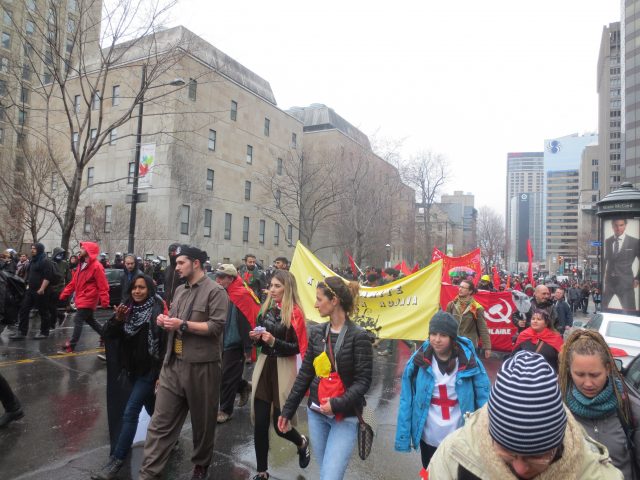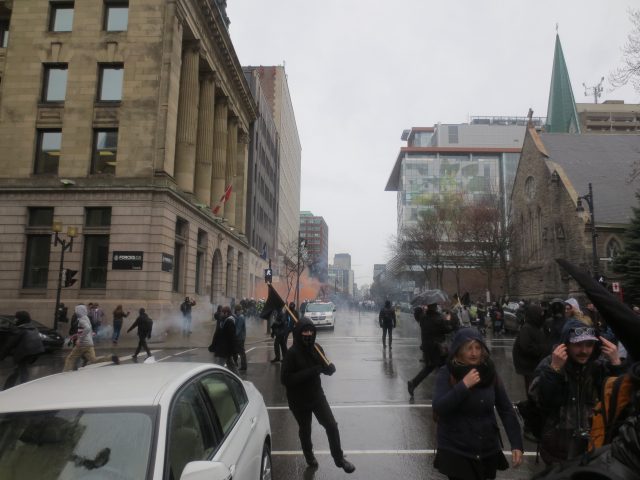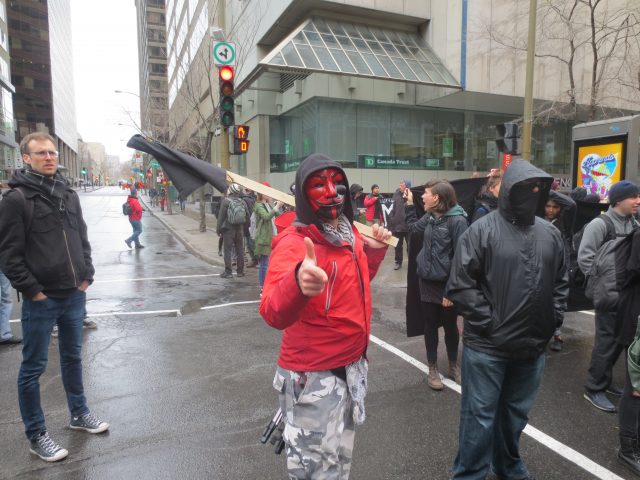On Sunday May 1, hundreds took to the streets for an anti-capitalist protest in honour of International Workers’ Day. Less than an hour into the demonstration, police officers used tear gas and stun grenades to disperse the crowd, after a confrontation on Ste. Catherine Street escalated rapidly. Multiple arrests were made in the hours that followed, as police pursued small groups of protestors throughout the downtown area.
Anti-capitalist protesters gathered at several prearranged meeting points earlier that afternoon, forming smaller groups which coalesced into one large demonstration at the corner of University and de Maisonneuve at around 3:15 pm.
There was a heavy police presence, with dozens of vehicles gathered on nearby streets, a helicopter monitoring the area, and several officers on horseback following the demonstration closely. As protesters made their way through downtown Montreal, rows of officers in riot gear arrived to follow the procession from the sidelines, standing in front of businesses and government buildings.
The anti-capitalist demonstration was organized by the Montreal chapter of Convergence des luttes anticapitalistes (CLAC-Montreal), and attracted a diverse collection of protesters, which included a small but enthusiastic McGill contingent. In addition to the usual anti-capitalist and anti-police chants, shouts of “Free Palestine!” and “Free Kurdistan!” could be heard from the crowd.
“The only way to completely address climate change is to not only limit greenhouse gas emissions but to also tackle the social problems that make marginalized people most vulnerable to the changing climate.”
Environmental activists were also in attendance. The Daily spoke with McGill student Jed Lenetsky, a U1 Environmental Sciences student, about the intersection between anti-capitalist activism and the climate justice movement:
“The shift towards a clean energy economy must include a just transition for workers.”
“Climate justice is firmly based in intersectionality,” said Lenetsky. “The only way to completely address climate change is to not only limit greenhouse gas emissions but to also tackle the social problems that make marginalized people most vulnerable to the changing climate. Fighting for labor rights fits squarely within this mandate.”
Speaking to The Daily, Kristen Perry, a graduating McGill Environmental Sciences student, stressed that “the shift towards a clean energy economy must include a just transition for workers.”
“This means organizing for a living wage and fair working conditions,” Perry said.
Confrontation and Arrests
The protesters marched through the streets of downtown Montreal for nearly a half hour without incident. Small amounts of tear gas were fired on at least two occasions, for reasons that remain unclear, and a number of construction pylons were knocked into the street.The overall situation remained peaceful until the crowd arrived at a police station on Ste Catherine Street.
A confrontation ensued which ended with copious amounts of tear gas fired at protesters. Police also used stun grenades to scatter the crowd.
Some protesters hurled firecrackers and coloured smoke bombs back at the officers, and a window in an adjacent building was shattered. According to CBCNews, police claim protesters began the confrontation, throwing fireworks and tear gas upon arriving at the police station. However, two activists who wished to remain anonymous told The Daily that they witnessed the incident, claiming a tear gas canister caused the damage.
“[The police] shot some tear gas, and it broke a window,” said one of the activists, speaking to The Daily in French. “But it will probably be said that it was protesters that broke the window.”
The activists also told The Daily that they had been attending a feminist conference and had decided to join the demonstration because “when you’re feminist, you’re struggling for more equality, for rights, for recognition, and when you’re anti-capitalist it’s similar. […] It’s essential not to separate the [feminist and anti-capitalist] movements.”
Following the confrontation on Ste. Catherine, small groups of protesters ran down adjoining side streets, pursued by police officers. For the rest of the afternoon, dispersed groups all over downtown Montreal tried to reunite while avoiding the police. Several were detained during this period, with the total number of arrests reported to be at least ten by various news sources, including CBCNews and The Toronto Star.
“[The police] shot some tear gas, and it broke a window. But it will probably be said that it was protesters that broke the window.”
Among those arrested were two McGill students, who preferred to remain anonymous. In an interview with The Daily, the two students said they had been walking peacefully along a downtown sidewalk when a large number of police officers arrived to disperse their group. They were pushed down an alley along with some other protesters and were eventually trapped by the police.
They were then arrested, allegedly for “participating in an illegal demonstration,” despite the fact that they had not been protesting when the police appeared. The officers did not cite any specific piece of legislation, but they still handcuffed and frisked the students, and searched through their coats and bags. Eventually, the students were released without charges. One student told The Daily that she found bruises the next day where the police had held her, and that other students with her were treated more roughly.
“The Police are Our Partners”
Meanwhile, The Daily’s reporter followed another group to Dorchester Square, where a large number of officers scattered protesters with substantial amounts of tear gas. Julie, a McGill student present at the scene, expressed outrage at what she saw as the police’s heavy-handed behaviour:
“I’m feeling frustrated that people who were trying to recover after being chased were then attacked, not only with tear gas, but then [also by] ten or twenty policemen on bikes shouting […] and chasing them […] in the middle of a park!”
She emphasized that police filled the park with tear gas without making sure that bystanders would be affected. These concerns echoed last year’s May Day demonstration, during which passers-by, including children, were teargassed as the police attempted to disperse protesters.
“[The officer] hit her in the leg and then pummelled her, and they then proceeded to hound us.”
Sean, another McGill student, told The Daily what happened when he and a few others were chased onto campus near the Otto Maass Chemistry Building by police:
“Some of the police followed the group going up University, and other officers stopped and started harassing us, and attacked one student – I think she was a student – with a bike. [The officer] hit her in the leg and then pummeled her, and they then proceeded to hound us,” he said.
“Meanwhile, I confronted [a] McGill Security [officer] about this, telling him ‘the police are attacking students on campus, it’s your responsibility to make sure this kind of thing isn’t happening’, and he said ‘the police are our partners.’”
“He said ‘the police are our partners.’”
At around 6:00 pm, roughly a hundred demonstrators gathered at Philips Square, and marched east to Place des Festivals. There, the group dispersed when police arrived, and about a half an hour later, CLAC-Montreal announced via Twitter that the demonstration was officially over.




